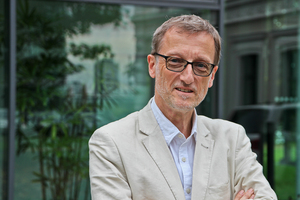Prof. Dr. Thomas Dreier
Karlsruher Institut für Technologie (KIT) and Albert-Ludwigs-Universität Freiburg
Curriculum Vitae
Thomas Dreier studied law at the Universities of Bonn and Geneva and completed his first state examination (bar exam) in 1982, before obtaining a Master of Comparative Jurisprudence at the New York University School of Law in 1983 and passing his second state examination (bar exam) in Munich in 1986. From 1987 to 1999 he was legal desk officer at the Max Planck Institute for Innovation and Competition in Munich. In 1990, he obtained his doctorate degree in law from LMU Munich, where he also pursued studies in art history (under Hans Belting, among others). From 1992 to 1999, Thomas Dreier taught at the Münchner Fachakademie für Fotodesign and, from 1997 to 1998, was professeur invité at the Université Toulouse I. In 2000, he completed his habilitation at LMU Munich with a treatise on “Kompensation und Prävention. Rechtsfolgen unerlaubter Handlungen im Bürgerlichen, Immaterialgüter- und Wettbewerbsrecht” (“Compensation and Prevention. Legal consequences of impermissible actions in Private, Intellectual Property and Competition Law“). Since the winter semester 1999/2000, he is Professor for Private Law and legal issues in the information society at the University of Karlsruhe (now: Karlsruhe Institute for Technology, KIT) and since 2001 simultaneously qualified honorary professor and member of the faculty of law at the University of Freiburg. Further, Professor Dreier held guest professorships at the New York University of Law, the University of Haifa as well as the National University of Singapore and is vice president of the Association littéraire et artistique international (ALAI) as well as a board member at the Institut für Kunst und Recht (IFKUR) and at the information platform iRights.org. From October 2014 to September 2015, Thomas Dreier was Fellow at the Käte Hamburger Center for Advanced Study in the Humanities “Law as Culture”. Since October 2015, he is Senior Fellow at the Center.
Research Project
Regulating vision – Normative visual rules and visual images
One of the ways in which law and the arts interact is the effects of images and the attempts that have been made to regulate them through law. On the one hand, these attempts reflect the ambivalent consciousness that images are nothing yet but are capable of much, as expressed throughout history from the aniconism under Moses to current day requirements to present images of cancer on cigarette packages. On the other hand, there is the issue of the rivalry between image and speech, along with their mutual linkages in form of reading images or visualizing texts.
The theory of images developed over the past decades, however, has a surprising lacuna. While there have, by now, been conducted a series of studies in neighboring disciplines (Sociology; History; Neuroscience, and others), an investigation into the normative – i.e. legal – regulation of how images are created, disseminated and used in a societal context is absent. This lacuna is mirrored in legal literature. Few exceptions aside, legal literature offers several compendia of legal regulations pertinent to visual artists and particularly photographers (of poor academic quality), but has as yet failed to systematically address the image theoretical conditions for the legal regulation of the practical usage of images. The object of the present project funded by the Käte Hamburger Center for Advanced Study in the Humanities "Law as Culture" is to close this lacuna – or rather these lacunae – within visual science and law by means of interdisciplinary methodology while simultaneously investigating the underlying relationship between image and text.
Legislature and jurisprudence have developed a voluminous system of norms that considers the most varied points of view concerning analog pictures (standards of proof, copyright/moral rights, privacy protection, surveillance) that can be considered a historically grown corpus. Due to the technology neutrality of most legal norms, these are largely applied without variation to digital images. This raises the question to what extent the law does justice to the profound changes that digitalization and networking entail for the production, dissemination and consumption of images, particularly in the image-saturated Western world. For the decreasing nature of images as indices that continue to be understood by viewers as reproductions increasingly approximates the quality of technical images. These, however, are no longer reproductions but visualizations of data, the production and readability of which presupposes the existence of extra-imagery model images.
Publications (selected)
- Urheberrecht. Kommentar (co-authored with Gernot Schulze), 4th edition., München: C.H.Beck-Verlag 2013.
- Plagiate. Wissenschaftsethik und Recht (Ed. along with Ansgar Ohly), Tübingen: Mohr Siebeck 2013.
- Original und Kopie im rechtlichen Bildregime, in: Ariane Mensger (Ed.): Déjà-vu? – Die Kunst der Wiederholung von Dürer bis You Tube, Ausstellungskatalog, Staatliche Kunsthalle Karlsruhe, Bielefeld: Kerber 2012.
- Das Recht des Theaters. Das Recht der Kunst auf Reisen (Ed., along with Matthias Weller/Nicolai Kemle/Markus Kiesel/Peter M. Lynen), Baden-Baden: Nomos-Verlag 2011.
- Die systematische Aufnahme des Straßenbildes. Zur rechtlichen Zulässigkeit von Online-Diensten wie "Google Street View" (co-authored with Indra Spiecker gen. Döhmann), Baden-Baden: Nomos-Verlag 2010.


